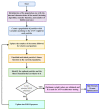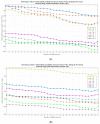Neuro-Particle Swarm Optimization Based In-Situ Prediction Model for Heavy Metals Concentration in Groundwater and Surface Water
- PMID: 35202281
- PMCID: PMC8879014
- DOI: 10.3390/toxics10020095
Neuro-Particle Swarm Optimization Based In-Situ Prediction Model for Heavy Metals Concentration in Groundwater and Surface Water
Abstract
Limited monitoring activities to assess data on heavy metal (HM) concentration contribute to worldwide concern for the environmental quality and the degree of toxicants in areas where there are elevated metals concentrations. Hence, this study used in-situ physicochemical parameters to the limited data on HM concentration in SW and GW. The site of the study was Marinduque Island Province in the Philippines, which experienced two mining disasters. Prediction model results showed that the SW models during the dry and wet seasons recorded a mean squared error (MSE) ranging from 6 × 10-7 to 0.070276. The GW models recorded a range from 5 × 10-8 to 0.045373, all of which were approaching the ideal MSE value of 0. Kling-Gupta efficiency values of developed models were all greater than 0.95. The developed neural network-particle swarm optimization (NN-PSO) models for SW and GW were compared to linear and support vector machine (SVM) models and previously published deterministic and artificial intelligence (AI) models. The findings indicated that the developed NN-PSO models are superior to the developed linear and SVM models, up to 1.60 and 1.40 times greater than the best model observed created by linear and SVM models for SW and GW, respectively. The developed models were also on par with previously published deterministic and AI-based models considering their prediction capability. Sensitivity analysis using Olden's connection weights approach showed that pH influenced the concentration of HM significantly. Established on the research findings, it can be stated that the NN-PSO is an effective and practical approach in the prediction of HM concentration in water resources that contributes a solution to the limited HM concentration monitored data.
Keywords: groundwater; heavy metals; neural network; particle swarm optimization; surface water.
Conflict of interest statement
The authors declare no conflict of interest.
Figures










































Similar articles
-
A Hybrid Neural Network-Particle Swarm Optimization Informed Spatial Interpolation Technique for Groundwater Quality Mapping in a Small Island Province of the Philippines.Toxics. 2021 Oct 21;9(11):273. doi: 10.3390/toxics9110273. Toxics. 2021. PMID: 34822664 Free PMC article.
-
Fuzzy-based prediction of solar PV and wind power generation for microgrid modeling using particle swarm optimization.Heliyon. 2023 Jan 5;9(1):e12802. doi: 10.1016/j.heliyon.2023.e12802. eCollection 2023 Jan. Heliyon. 2023. PMID: 36704286 Free PMC article.
-
Seminal quality prediction using data mining methods.Technol Health Care. 2014;22(4):531-45. doi: 10.3233/THC-140816. Technol Health Care. 2014. PMID: 24898862
-
Application of particle swarm optimization to water management: an introduction and overview.Environ Monit Assess. 2020 Apr 13;192(5):281. doi: 10.1007/s10661-020-8228-z. Environ Monit Assess. 2020. PMID: 32285219 Review.
-
Artificial intelligence techniques in electrochemical processes for water and wastewater treatment: a review.J Environ Health Sci Eng. 2022 Oct 1;20(2):1089-1109. doi: 10.1007/s40201-022-00835-w. eCollection 2022 Dec. J Environ Health Sci Eng. 2022. PMID: 36406623 Free PMC article. Review.
Cited by
-
Quantitative Assessment and Spatial Analysis of Metals and Metalloids in Soil Using the Geo-Accumulation Index in the Capital Town of Romblon Province, Philippines.Toxics. 2022 Oct 22;10(11):633. doi: 10.3390/toxics10110633. Toxics. 2022. PMID: 36355926 Free PMC article.
-
Statistical Assessment, Modeling, and Mitigation of Water and Soil Pollution.Toxics. 2022 May 18;10(5):261. doi: 10.3390/toxics10050261. Toxics. 2022. PMID: 35622674 Free PMC article.
-
In Situ Measurements of Domestic Water Quality and Health Risks by Elevated Concentration of Heavy Metals and Metalloids Using Monte Carlo and MLGI Methods.Toxics. 2022 Jun 21;10(7):342. doi: 10.3390/toxics10070342. Toxics. 2022. PMID: 35878248 Free PMC article.
-
Viability of two adaptive fuzzy systems based on fuzzy c means and subtractive clustering methods for modeling Cadmium in groundwater resources.Heliyon. 2023 Jul 18;9(8):e18415. doi: 10.1016/j.heliyon.2023.e18415. eCollection 2023 Aug. Heliyon. 2023. PMID: 37520981 Free PMC article.
-
Design and Implementation of a Chain-Type Direct Push Drilling Rig for Contaminated Sites.Int J Environ Res Public Health. 2023 Feb 20;20(4):3757. doi: 10.3390/ijerph20043757. Int J Environ Res Public Health. 2023. PMID: 36834448 Free PMC article.
References
-
- Nem Singh J., Camba A. The role of domestic policy coalitions in extractive industries’ governance: Disentangling the politics of “responsible mining” in the Philippines. Environ. Policy Gov. 2020;30:239–251. doi: 10.1002/eet.1905. - DOI
-
- Obasi P.N., Akudinobi B.B. Potential health risk and levels of heavy metals in water resources of lead–zinc mining communities of Abakaliki, southeast Nigeria. Appl. Water Sci. 2020;10:184. doi: 10.1007/s13201-020-01233-z. - DOI
-
- Carvalho F.P. Mining industry and sustainable development: Time for change. Food Energy Secur. 2017;6:61–77. doi: 10.1002/fes3.109. - DOI
-
- Ali H., Khan E., Ilahi I. Environmental chemistry and ecotoxicology of hazardous heavy metals: Environmental persistence, toxicity, and bioaccumulation. J. Chem. 2019;2019:6730305. doi: 10.1155/2019/6730305. - DOI
Grants and funding
LinkOut - more resources
Full Text Sources

